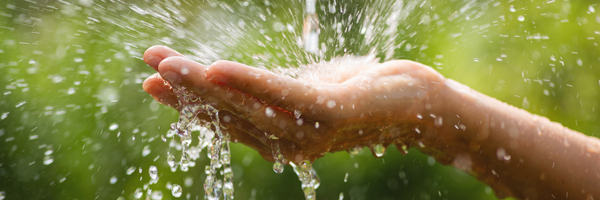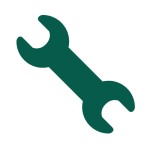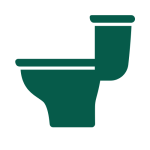Water Conservation
Water is possibly our most precious, yet undervalued natural resource. This guide will explore how to reduce and recycle water. Water conservation is very important since demand is on the rise and some water supplies are declining. A safe and secure water supply can no longer be taken for granted, so we must reassess our attitudes toward water. By practicing some basic rules of conservation we can play an important part in improving our water quality and reducing the quantity we use.
Approximately 97% of Earth’s water is salt water. That leaves only about 3% of that as freshwater for meeting the needs of people, animals, and plants. Of that 3% less than a quarter is available for us to use. The rest is frozen solid in glaciers and in the polar ice caps. This should make you think twice the next time you flush the toilet, brush your teeth, or drink a glass of water. If we keep the surface water and groundwater in good condition, we can all play a part in conserving this precious resource.
In the home, we use far more water than is necessary, and we can cut back significantly without even noticing. Water conservation will not reduce your quality of life in any way. In fact, once you learn how to reduce your usage, you can save big on your water bill!
On average, every Canadian uses about 350 litres (80 gallons) each day – just indoors. During the summertime, lawn watering and car washing can increase water use by up to 50%.
Follow the 3 Golden Rules of Conservation whenever possible
Click on any of the following areas of your home to read more about how to conserve water there.
Conservation Begins at Home
In the Kitchen
- Fruits and vegetables should be cleaned in a partially filled sink – not under a running tap.
- When boiling vegetables use only enough water to cover them, steaming is better because it uses less water and retains more essential nutrients.
- Keep a water container in the refrigerator. This avoids running the tap in order to get a cold drink.
- Always fill the dishwasher completely before cleaning a load. Dishwashers use between 35 and 45 litres per cycle and hand-washing dishes use about the same amount each time you wash.
- Set the dishwasher on the “energy saver” or shortest cycle.
- Drippy faucets lose a tremendous amount of water. Have them fixed or replaced.
- Install a water-efficient faucet aerator or a swivel sprayer.
In the Bathroom
The bathroom accounts for about 65% of the water used within the home.
- Install a water-saving aerator on the end of the faucet spout.
- When shaving, fill the sink up a few inches to rinse the shaver, never keep the water running.
- When brushing your teeth, don’t leave the water running.
- A shower uses much less hot water than bathing in a full tub. For those who prefer to bathe, it is not necessary to fill more than half of the tub.
- Only toilet paper and human waste should ever be flushed. Never flush feminine hygiene products, “flushable” wipes, paints, oils, solvents or other chemicals down the toilet.
- Showers are the second highest user of water in the house and regular showerheads flow at a rate of about 20 litres per minute. Newer, more efficient showerheads use just 8 litres per minute. Although they use less water, the jets are designed to maintain the feeling of a higher flow.
- A leaking toilet valve can do major damage to your conservation efforts. A toilet that runs continuously can leak enough in one year to fill an entire swimming pool.
In the Outdoors
Lawn Watering
The average lawn may need about 100,000 litres of water in a growing season. Most often lawns are overwatered and there is run off. Watering in the midday sun results in evaporation, therefore the best time to water your lawn is in the early morning or late afternoon. After heavy rains, watering may not be needed for a week or more.
In dry summer conditions, lawns go dormant. It is not dead; it is growing at a slower rate, which is normal. When frequent rains return, the lawn will become green again. Watering can cause the lawn to come out of dormancy and “browning” can occur if allowed to go dormant again in the same season.
For plant watering, drip irrigation through porous tubes delivers water to the root zone efficiently. Soaker hoses with holes pointed toward the ground are also efficient. Oscillating sprinklers are the worst offenders since they lose as much as 50% through evaporation.
A low-maintenance landscape means keeping thirsty turf grass to a minimum. Turf can be totally replaced with native ground covers that require little watering and cutting. Plants and bushes native to the region usually require no water except what the sky delivers.
Also, consider using a rain barrel. Read more about them below!
Learn more about lawn watering restrictions that happen annually from May 15 – September 15.
The average car wash takes requires over 150L of water. Car washes during the summer increase water usage by nearly 15%. Luckily, there are a couple tricks you can follow that will keep your car shiny, and save you money on your monthly water bill. Though it is best to hold off on washing your car for as long as possible, if needed try to follow some of the following tips.
- If possible, there are many waterless car wash solutions available on the market.
- Installing a low-flow nozzle on your hose will allow you to easily shut off your hose when it’s not in use.
- Instead of using an open hose, pre-fill a bucket of water and a wet sponge to help rinse your vehicle.
- Sunlight can cause water to evaporate quicker, try washing your car in a shaded area.
A rain barrel will also prevent heavy runoff by temporarily holding rain. The rainwater can later be used or emptied onto a permeable surface or a landform to allow it to infiltrate. Rain barrels can be simply a barrel, or can include special features such as spigots for attaching garden hoses, filters, mosquito-proof mesh, and child and animal-proofing.
Benefits
- Rain barrels drastically reduce runoff with low costs and minimal maintenance.
- Simple to install, suitable for virtually any household property size or location
- Stores relatively clean (and unchlorinated) water for use on lawns and gardens.
- Can reduce domestic water use, lowering water bills and demands on County’s water system, especially during peak summer periods.
- If used and maintained properly there can be a reduction of 65–70% of runoff.
A few tips
- Install the rain barrel on a strong, level surface as it can weigh up to 1200 lbs. when full — a patio or paving stone is ideal.
- If the barrel is slightly elevated, a hose can use gravity to feed water to a garden or lawn.
- To limit mosquito breeding, ensure that your barrel is vector/mosquito-proof. Most manufactured rain barrels come with this feature.
- Rainwater collected in your barrel is ideal for watering your garden, but not recommended as drinking water.
- Clean and maintain your eavestroughs and downspouts of leaves and debris, to prevent clogging of spouts or the barrel.
- Drain your rain barrel before the winter – water will freeze and can crack the barrel.




